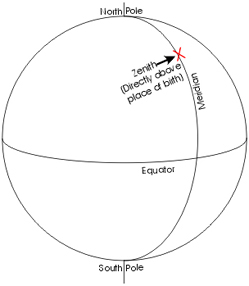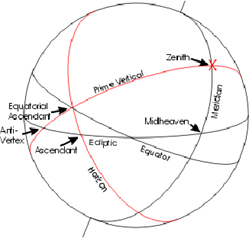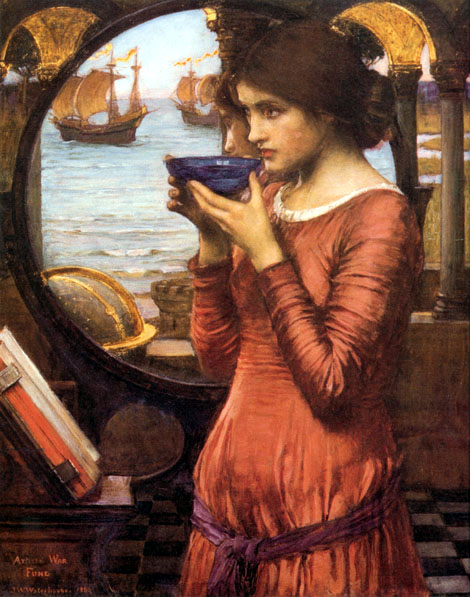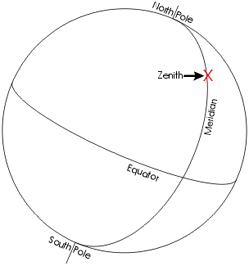|
"Destiny" by John William
Waterhouse
(1849-1917)
By
John Townley
Although most
astrology software programs include the
option of the Vertex in the natal chart, few astrologers actually use
it, so there isn’t much written about it. I was a student of
Charles Jayne, who along with L. Edward Johndro pioneered its use, so
here is what I learned about it from him and subsequently from my own
practice.
What
it is
The Vertex is the
intersection of the prime vertical
(the local perpendicular East-West plane) with the ecliptic in the
West. Look straight up, then look West, and there it is, either above
or below the horizon (7th house cusp) usually within a house or two.
How
to calculate it
If you
don’t have a computer that does it for you
and have a table of houses, you look up the IC as if it were the MC and
then go to the Asc for the co-latitude (90-birth latitude) of birth.
That’s the Vertex.
When
it got noticed
Astrologers never
used this point for interpretation
until electrical engineer and astrologer L. Edward Johndro and
astrologer Charles Jayne began to do so in the 1940s. Johndro called it
the “Electric Ascendant” as he believed the
physical basis
of astrology to be electromagnetic and so divided up its major
components into electrical and magnetic natures, complementary to each
other as they are in a wire conducting a current, in which the electric
charge moves along a wire and creates a magnetic field at right angles
to it. He believed the ordinary Ascendant on the horizon plane to be
the Earth's magnetic component spatially, and the prime vertical at
right
angles to it to be the electric component, hence the title. After
looking at it in various horoscopes, he and Jayne proposed a meaning
for it which is important, unique, and rather vague all at the same
time.
What
it means
Jayne taught that
it was a point of fate or destiny
(older astrologers threw those words around a lot), at which things
happened that determined the path of your life. They could be large and
obvious or small and seemingly insignificant at the time, but you would
look back later and say everything changed at that point, in
retrospect. How that actually seems to happen depends on whether it is
a transit or progression to a natal chart, the comparison of
one
natal to another, or in a relocation. In a transit or progression, you
can expect an event that will be life-changing, of the nature of the
transiting or progressed planet involved, for good or ill. And,
conveniently (or rather inconveniently), you may miss it entirely at
the time, but it will begin to become clear as time passes. Hint: keep
your eyes open to blossoming developments in the rear view mirror. I
haven’t
seen a lot of concrete effects here, but other astrologers
claim
they have.
Comparisons are
another matter, and here the Vertex
seems to play a major role. People with a planet on your Vertex,
particularly the Sun, tend to have inordinate effect upon you,
regardless of who they are. Quite often you’ll find that
contact
in marriage charts and in repeated love affairs, the result of which
can be you find yourself recurringly involved with the same rising
sign, because that sign’s Vertex tends to fall on your Sun or
other important planet. The contact can be with a spouse, an important
teacher, or some other major mentor and obviously life-changing contact
– or it can be with someone whom you hardly know but who does
something that critically alters your life, like the stranger on the
curb who sticks his arm out to block your path as you are about to step
in front of an oncoming car. In synastry, it’s a factor to
definitely include, as it’s usually important. If someone has
a
planet or angle on your Vertex, be particularly aware, as it may be
stickier and have a longer-lasting effect on you than you might
surmise. As in other crossovers, that may warn you against a number of
problematic birth years which have the outer planets posited on your
Vertex. People born then could be conduits for trouble, simply because
of their age. Conversely, the
day the Sun is on your Vertex in any year produces people who can help
you immensely, even without meaning to, and in ways neither of you may
immediately recognize. Of course, you probably won't see it clearly
until it's already happened, which is what gives the "fate",
"destiny", and "karma" flavor to the point, since you don't have the
control and
free will you'd like to, and are by definition blindsided. Along with
nodal contacts, Vertex contacts give you a particularly strong feeling
of being connected to a larger cosmic family
that crosses the
ages, connected by planetary degrees.
Perhaps equally
important is its role as the third angle
in locational astrology. A location is considered strong if you have
one natal planet rising and another on the MC (sometimes called an
astrodyne), so if you add another on the Vertex, it makes that spot
even more
important. When you’re there, you get a triple whammy each
day
when that set of three degrees hits all three angles. It would be
useful to
have it on AstroCartography maps, but no program includes it to date.
The best you can do is look for crossing lines and then cast a chart
for that spot to see if the Vertex is included as well.
In general, the
Vertex falls in with the lunar nodes as
having the feeling of fated destiny, contact with other worlds and
other lives where there’s more going on than meets the eye
and
it’s critically important, to boot. Why it should be so is
anybody’s guess, but then, why not? The prime vertical is not
left out in astrology in other ways – the now-popular Koch
house
system is based on time measured along the prime vertical, so why not
use the Vertex? Actually, more curiously, why is not the Anti-Vertex
equally used, the intersection of the prime vertical and the ecliptic
in the East, near the normal Ascendant? Actually, in my experience,
it’s the axis itself that is important, not just one or the
other, though the Vertex shows up more dramatically in partnerships,
being the 7th house cusp in a complete set of houses projected upon the
prime vertical.
So, go put the
Vertex into all of your charts, if you
haven’t already, and see if Destiny awaits you and your Fate
is
to have been missing it all these years…
|








